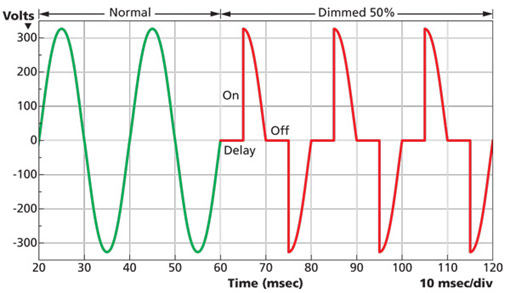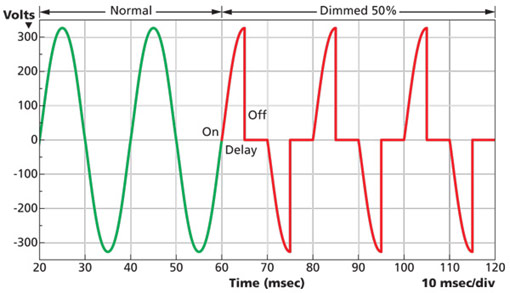
When it comes to creating the perfect ambiance in your home or office, lighting is key. And with the rise of LED lighting, it’s important to have the right dimmer to control the brightness and mood of your space. Trailing edge dimmers are a popular choice for LED lights, but with so many options on the market, it can be overwhelming to choose the right one for your space. In this article, we’ll discuss the key factors to consider when selecting a trailing edge dimmer.
Introduction
What trailing edge dimmers are
A trailing edge dimmer, also known as reverse phase dimmer, is an electronic device used to regulate the intensity of light produced by lamps. It works by cutting off the current at the end of each cycle of alternating current, which is known as the “trailing edge”.

This type of dimmer is used to control the lighting levels in a room, and is particularly useful for LED lights, which are increasingly becoming the preferred choice of lighting for many households. Trailing edge dimmers are considered to be more efficient than the traditional leading edge dimmers, as they are able to reduce the amount of power used to power the lights.
History and evolution of dimming technology
Dimming technology has been around for centuries, but only in recent years has the technology become more accessible and widely used. The earliest dimmers used a rotary knob that manually adjusted the voltage level passing through the lamp. This type of dimmer was inefficient and wasteful, as much energy was lost in the form of heat.
In the late 1980s, leading edge dimmers were introduced, which used a triac to control the voltage passing through the lamp. This allowed for more precise control of the dimming process, but was prone to flickering and humming. Trailing edge dimmers were then developed, which used a higher frequency to reduce flickering and humming, and allowed for a more efficient and precise dimming process.
As the technology continues to improve, dimming systems are becoming increasingly popular, as they are more energy efficient and provide more precise control over the lighting levels in a room.
Technicals about Trailing edge dimmer
How trailing edge dimmers work
A trailing edge dimmer is an electrical device that is used to adjust the brightness of lights in a room or space. It works by reducing the voltage supplied to the light source, resulting in a dimmer and softer light.
The dimmer works by creating a “trailing edge” effect, which is when the voltage at the end of the waveform is reduced, rather than the beginning. This allows for more precise and gradual dimming than a leading edge dimmer, which reduces the voltage at the start of the waveform. Trailing edge dimmers are generally used with LED lighting, and they are typically more efficient and produce less heat than leading edge dimmers.
Additionally, trailing edge dimmers are better at dimming LED lights than leading edge dimmers, as they are able to create a smoother dimming effect.

Key components and their functions
The key components of a trailing edge dimmer are the dimmer switch, the linear dimmer control, and the triac.
The dimmer switch is used to select the desired level of brightness, and the linear dimmer control is used to adjust the voltage supplied to the light source. The triac is an electronic switch that controls the current and voltage supplied to the light source, and it is used to create the trailing edge effect. The triac is typically located inside the dimmer switch, and it is triggered by the linear dimmer control.
The dimmer switch is the main user interface, and it is used to select the desired level of brightness. The linear dimmer control is a knob or slider used to adjust the voltage supplied to the light source, and it is typically located near the dimmer switch. The triac is an electronic switch that is triggered when the linear dimmer control is adjusted, and it is used to reduce the voltage supplied to the light source, resulting in the trailing edge effect.
Differences between leading edge and trailing edge dimming.
When it comes to dimmers, there are two main types: leading edge dimmers and trailing edge dimmers. Leading edge dimmers are the more traditional type of dimmer, and are often used for incandescent and halogen lights. Trailing edge dimmers, on the other hand, are a relatively new technology that has become increasingly popular with LED lights. Trailing edge dimmers offer a smoother, more efficient dimming control, and are typically the preferred type of dimmer for LED lights.
Leading edge dimming
Leading edge dimmers cut the initial spike of the AC voltage waveform when the dimmer switch is turned down. This makes the light less bright. However, leading edge dimmers can cause a buzzing sound when used with LED lights because they are not designed for LED technology.
Leading Edge Dimming, also called TRIAC dimming, turns off the current at the beginning of the AC waveform, right after it crosses zero. It is often used with incandescent bulbs and causes a voltage surge every half cycle, increasing the current to the light source.

Trailing edge dimming
Trailing edge dimmers, on the other hand, work by cutting off the trailing edge (the end of the AC voltage waveform) of the AC voltage waveform when the dimmer switch is turned down. This type of dimmer is specifically designed to work with LED lights, resulting in a smoother dimming experience with no buzzing or humming sound. Trailing edge dimmers are also more energy efficient than leading edge dimmers, making them a better choice for those who want to save energy while still controlling the brightness of their LED lights.
Trailing Edge Dimming, or electronic dimming, operates by cutting off the current as the AC waveform concludes, right before crossing zero. This dimming method is often paired with electronic drivers and is designed to avoid sudden voltage spikes, thereby preventing a surge in current to the light source.
Types of Trailing Edge Dimmers
Various models and brands in the market
Trailing edge dimmers are available in various models and brands in the market. These dimmers come in two main types: traditional incandescent dimmers and LED trailing edge dimmers.
The traditional incandescent dimmers are designed to dim incandescent bulbs. They typically feature a small slider that is used to adjust the light intensity. On the other hand, LED trailing edge dimmers are specifically designed for LED bulbs. They work differently than traditional incandescent dimmers and use a different circuit that allows for smoother and more precise dimming.
LED dimmers also tend to be more energy efficient compared to incandescent dimmers. This means that they consume less energy while providing the desired level of brightness.
When it comes to the specifications and technical differences, LED trailing edge dimmers are designed to handle the unique characteristics of LED bulbs. They have lower minimum load requirements and are compatible with a wider range of LED bulbs. Additionally, they often feature features like adjustable dimming curves, which allow users to customize the dimming behavior according to their preferences.
In the market, you can find various models and brands of trailing edge dimmers that cater to different needs and budgets. Some popular brands include Lutron, Leviton, Legrand, and Philips. It is recommended to choose a dimmer that is compatible with your specific type of bulbs and offers the desired features for your lighting setup.
Specifications and technical differences.
Trailing edge dimmers are available in various brands, each with its own specifications and technical differences. Here are some of the key differences you may come across when comparing different brands of trailing edge dimmers:
1. Load Capacity: Trailing edge dimmers have a minimum and maximum load capacity, which refers to the range of wattages they can handle. Different brands may have different load capacities, so it’s important to choose a dimmer that can accommodate the wattage of your LED bulbs.
2. Compatibility: Some brands of trailing edge dimmers are specifically designed to be compatible with certain types of LED bulbs. It’s crucial to check the compatibility of the dimmer with the specific LED bulbs you plan to use. This information is usually provided by the dimmer manufacturer.
3. Dimming Range: The dimming range refers to the extent to which a dimmer can reduce the brightness of the LED bulbs. Different brands may offer different dimming ranges, so it’s worth considering this factor if you require a wide range of dimming options.
4. Dimming Curve Options: Certain brands of trailing edge dimmers provide adjustable dimming curves. This feature allows you to customize the dimming behavior according to your preferences. For example, you may prefer a gradual dimming curve or a more abrupt one. This flexibility can enhance your overall lighting experience.
5. Extra Features: Some brands may offer additional features such as remote control capabilities, compatibility with smart home systems, or the ability to create preset lighting scenes. These extra features can add convenience and versatility to your lighting setup.
When comparing different brands of trailing edge dimmers, it’s recommended to consider the specific technical requirements of your LED bulbs, as well as your personal preferences for dimming range and additional features. So I would like to recommend you our trailing edge dimmer, BQ-TTDIM.
Applications
Common uses in residential, commercial, and industrial settings.
Trailing edge dimmers are commonly used in residential, commercial, and industrial settings for controlling lighting levels. They work by reducing the amount of power going to the light, and as such, they can be used to dim or brighten lights.

Trailing edge dimmers are also known as reverse phase dimmers, as they use a reversed phase in the electrical circuit to control the light level. Trailing edge dimmers are designed to work with specific types of lighting, such as LED, halogen, and incandescent lights, so it’s important to check compatibility before installing them.
Additionally, they are available in both single-pole and three-way dimmer switches, which can be used to control multiple lights. Trailing edge dimmers are a reliable and affordable way to control the brightness of lighting in any setting.
Compatibility with different types of lighting (e.g., LED, halogen, incandescent)
Trailing edge dimmers are a type of dimmer specifically designed to be compatible with LED, halogen, and incandescent lighting.

They offer improved compatibility with LED lighting compared to leading edge dimmers, which are the traditional type of dimmer. Trailing edge dimmers operate by reducing the amount of energy sent to the light by gradually decreasing the voltage over time. This helps to prevent flickering, buzzing, and other problems that can occur with LED lighting when using a leading edge dimmer. Additionally, trailing edge dimmers are able to accurately dim LED lighting to a much lower level than what is possible with leading edge dimmers.
Advantages of Trailing Edge Dimmers
Improved compatibility with LED lighting
Trailing edge dimmers are designed to be compatible with LED lighting, as they are able to regulate the voltage and current of the lighting more effectively than traditional leading edge dimmers. This improved compatibility makes it easier to dim LED lights, and provides a smoother transition from bright to dim lighting. Trailing edge dimmers also help to reduce flicker and buzzing from LED lighting, making them a great choice for creating a pleasant ambiance in any room.
Benefits in terms of energy efficiency and lifespan of lighting
Trailing edge dimmers are particularly beneficial when used with LED lighting fixtures. Compared to traditional leading edge dimmers, trailing edge dimmers offer a range of advantages, including improved energy efficiency and longer lifespan for LED lighting.
The dimming process with a trailing edge dimmer is smoother and quieter, as well as more efficient. This is because the trailing edge dimmer reduces the voltage supplied to the lighting fixture, allowing for a more gradual dimming process. This helps reduce energy consumption and extends the lifespan of the lighting fixture. In addition, the trailing edge dimmer also reduces buzzing, providing a more pleasant experience for the user.
Enhanced control features (e.g., smoother dimming, less buzzing)
A trailing edge dimmer is an electronic dimming device that is used to control the brightness of LED lighting. Unlike leading edge dimmers, which are the traditional dimmers used with incandescent lighting, trailing edge dimmers provide enhanced control features such as a smoother dimming effect, less buzzing, and improved efficiency. This makes them ideal for LED lighting, as LED lighting is known to be sensitive to the control signals sent by the dimmer.

Trailing edge dimmers are also often referred to as reverse phase dimmers or trailing edge dimmers, and they are available in a variety of different designs.
Installation and Usage
Guidelines for installing trailing edge dimmers
Trailing edge dimmers are popular for LED lighting installations, due to their ability to provide smooth and precise dimming control. However, these dimmers do require some special considerations when it comes to installation and use. It is essential to follow the manufacturer’s instructions and safety guidelines when installing and using a trailing edge dimmer. This includes the following:
The proper size and type of dimmer for the LED lights being used, our trailing edge dimmer, BQ-TTDIM, is suitable for most of the dimmable LED lighting in the market.

Connecting the dimmer to the correct circuit.

Understanding the wiring diagrams and installation instructions.

Safety precautions and best practices.
It is also important to be aware of the safety precautions and best practices associated with trailing edge dimmers. This includes making sure that the load on the dimmer is not too high, and that the wiring and connections are correct. It is also important to use the proper type of dimming control, such as a trailing edge dimmer, to avoid potential damage to the LED lights or dimmer. Additionally, regular maintenance and inspection of the dimmer should be performed to ensure its proper functioning.
Tips for optimal usage and maintenance.
To get optimal performance from a trailing edge dimmer, some tips should be followed.
First, when selecting a dimmer, the load rating should be checked to make sure that it is compatible with the LED lights. Additionally, the wiring should be checked to ensure that it is properly connected to the dimmer. Regular maintenance and cleaning should also be performed to ensure that the dimmer is functioning properly. Lastly, if any issues are noticed with the dimmer, it should be serviced or replaced as soon as possible.
Following these tips will help ensure that the trailing edge dimmer will work correctly and provide optimal performance.
Challenges and Limitations
Potential compatibility issues
Trailing edge dimmers, while a great solution in many cases, come with a few potential challenges and limitations to consider.
One of the main issues is compatibility with LED lights, which can be difficult to achieve in some cases. There are a few potential solutions for this, such as using a compatible LED dimmer or using a compatible LED driver, but these come with their own limitations and cost considerations. When considering a trailing edge dimmer, it’s important to do the research and ensure compatibility with your LED lighting before deciding on a solution.
Cost considerations compared to other dimmers.
In addition to compatibility, cost is also an important factor to consider when deciding on a trailing edge dimmer. These dimmers can be more expensive than other types of dimmers, such as leading edge dimmers. However, they do offer greater control and flexibility, which can be beneficial in some applications. As such, it’s important to factor in the cost of the dimmer against the benefits it provides to determine if it’s the right solution for a particular project.
Conclusion
Recap of the key benefits and applications of trailing edge dimmers.
Trailing edge dimmers, also known as reverse phase dimmers, are an advanced type of dimmer that can be used for LED light bulbs, as well as traditional halogen and incandescent light sources. Trailing edge dimmers are characterized by their ability to provide smooth, consistent dimming of LED and other light sources, with minimal flickering and buzzing.
This makes them particularly beneficial in applications where precise dimming is needed, such as home theatres, commercial installations or any other space where lighting needs to be carefully controlled. Trailing edge dimmers are also more efficient than traditional leading edge dimmers, as they use less power to achieve the same amount of dimming. Additionally, in some cases, trailing edge dimmers are the only type of dimmer that is compatible with certain types of LED lighting, making them a must-have for any LED lighting installation.
Final thoughts on the role of trailing edge dimmers in modern lighting solutions.
Trailing edge dimmers have become an important part of modern lighting solutions, as they offer efficient and smooth dimming control for LED lights.
The technology of trailing edge dimmers is also becoming more sophisticated and flexible, allowing users to customize their lighting solutions to meet their needs and preferences. Trailing edge dimmers can be used to dim LED lights to the desired level, as well as to create unique lighting effects and moods. With the increased use of LED lighting solutions, trailing edge dimmers are likely to play an even more important role in the future.
boqi Own Design Trailing Edge Dimmer BQ-TTDIM
- Unique Design and Competitive Price
- Perfectly compatible with trailing edge dimmable lighting
- Widely Dimming Rang and Smoothly Dimming Effect
- Reliable Certificates for EU market
- 5 Years Warranty












